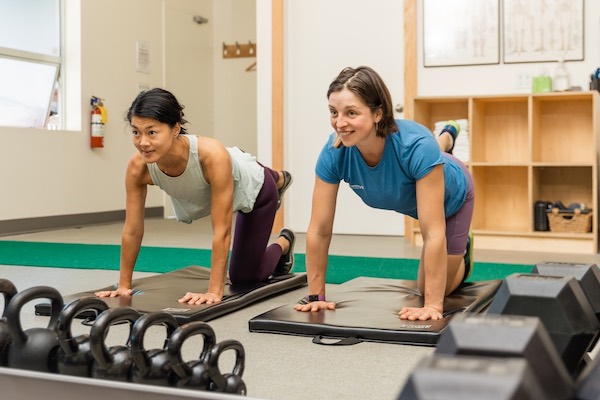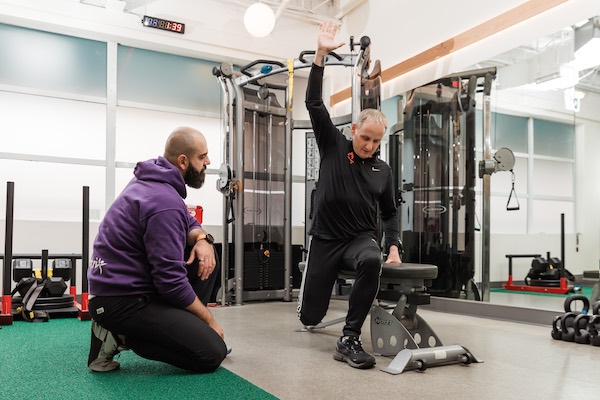For those battling lower back pain (LBP) and hip discomfort, a full night's sleep can often seem like an elusive dream. The combination of finding a comfortable sleeping position and managing pain can be challenging, and a bad sleep has real consequences. In this blog post, we'll delve into the power of kinesiology, focusing on building strength and enhancing mobility to help you make restful sleep a reality. As well, stay until the end for some sleep position and routine tips.
Understanding the Pain

Lower back pain and hip discomfort can stem from various sources, including muscle strains, ligament sprains, sciatica, or arthritis. Individuals with these conditions commonly experience pain and stiffness that worsens at night, disrupting their sleep and impacting their daily lives. Sometimes the pain at night is due to fatigue from the day which is more salient when the body is relaxed. Sometimes the pain at night is due to not moving during sleep, like in the case of arthritis.
Kinesiology: Empowering Strength and Mobility

Kinesiology, the science of body movement, offers holistic solutions to alleviate LBP and hip pain. By emphasizing strength-building and mobility-enhancing exercises, kinesiologists help individuals not only manage their pain but also improve their overall quality of life and sleep.
Negative Effects of Poor Sleep
For anyone who has experienced a bad sleep, it will come as no surprise that there are immediate and longer term consequences to a poor sleep. These consequences extend far beyond grogginess:
- Impaired Cognitive Function: Sleep deprivation affects concentration, memory, and decision-making abilities.
- Emotional Disturbances: Lack of sleep can lead to increased irritability, mood swings, and heightened stress levels.
- Weakened Immune System: Chronic sleep issues compromise the body's ability to fight infections, making individuals more susceptible to illnesses.
- Increased Pain Perception: Poor sleep amplifies pain sensitivity, worsening the experience of LBP and hip discomfort.
- Elevated Risk of Chronic Conditions: Insufficient sleep is linked to an increased risk of developing chronic conditions such as obesity, diabetes, and cardiovascular diseases. Sleeplessness messes with our insulin levels, making it harder to regulate our appetite and homeostasis.
[[cta-kin]]
How can kinesiology help with sleeping better?
The goal with a strength and mobility program would be to make the muscles that are hurting, and guarding to relax. This improves our sleep by allowing our bodies to hurt less at night, thus not interrupting our sleep. If we sleep better then, we recover faster. It’s a feedback loop that can spiral out of control, or be used in our favour to feel better. Here are the specifics:
Targeted Strength Exercises:

- Core Strengthening: Engage in kinesiology-designed core exercises to provide essential support to your lower back. A strong core can stabilize your spine and alleviate pressure on your hips and lower back during the day.
- Hip Strengthening: Work on exercises that target the hip muscles, enhancing their strength and stability. These exercises can include leg lifts, squats, and lunges, promoting better alignment and reduced discomfort.
Mobility-Focused Stretches:

- Hip Flexor Stretch: Stretching the hip flexors can relieve tension in the hips and lower back. Incorporate dynamic stretches to enhance flexibility and range of motion in the hips.
- Spinal Rotation Exercises: Gentle spinal rotations can improve mobility in the lower back, reducing stiffness and promoting relaxation, making it easier to find a comfortable sleeping position.
Posture Awareness:
- Ergonomic Evaluation: Seek to optimize your sleeping environment. From mattress firmness to pillow height, personalized ergonomic adjustments can make a significant difference in your sleep quality.
- Postural Exercises: A Kinesiologist can guide you in practicing proper posture throughout the day. An ergonomic workplace assessment can identify pain inducing positions which when corrected can alleviate strain on your lower back and hips.
Consistent Exercise Routine:
- Daily Mobility Routine: Establish a daily routine that incorporates mobility exercises and stretches. When our muscles are more flexible and relaxed they hurt less therefore finding a comfortable position at night is easier. Consistency is key; regular practice can significantly improve your overall flexibility and reduce pain. A kinesiologist can also help with this and build a customized active exercise rehab program.
Mindful Relaxation Techniques:
- Yoga and Meditation: Engage in gentle yoga or meditation practices before bedtime to relax your body and mind. These practices can enhance overall relaxation, making it easier to find a comfortable sleeping position and promote better sleep quality.
Other things you can do to get more comfortable:
- Back and side sleeping is considered better than stomach sleeping for the spine
- The right “squish” for your mattress and pillows are important as everyone is different. A mattress should have enough give, but not too hard that it hurts your body.
- Side sleeping: use a pillow in between your knees, or hug a big long body pillow with your knees and arms that puts your hips, back and knees into better alignment, keeps the hip and back muscles more relaxed and supported.
- Back sleeping: Sleeping with a bolster under your knees might feel good for 30 minutes, but could make you back and hips more sore in the mornings. If your hip flexors are too tight to lay flat, sleep on your side with a pillow between your knees.
Sleeping Routine:

Creating a sleep routine is important, it tells your body that it’s time to relax and sleep now. Just like children, adults should have a bedtime routine eg. “First I turn the lights down at 9pm, then I make my lunch for the morning, then I lay out my clothes for the morning, then I brush my teeth, then I have a hot shower, then I stretch for 5 min in bed, etc.”
If you’re currently in pain, having a hot shower, using a massage gun, foam rolling, stretching and/or using breathing techniques right before bed is a great way to relax your sore muscles and reduce your pain right before bed. That way hopefully you can find a more comfortable position and sleep faster and deeper.
As a night time routine makes us sleepy (bring on the melatonin). A morning routine that includes sunlight makes us wake up. Both are important to regulate circadian rhythm which includes hormones like cortisol and melatonin.
Our bodies respond well to routine and rhythm. That is why jet lag feels so bad. Keep the same schedule daily, that should help your sleep as well.
Conclusion:

Targeted strength exercises and mobility-enhancing techniques can transform your relationship with sleep along with a few other tricks like a sleep routine and an ergonomic position. Through kinesiology practices, you can embark on a journey towards pain-free nights and wake up each morning feeling refreshed, revitalized, and ready to face the day ahead.
Remember, your body is resilient, and with the right exercises and techniques, you can overcome the challenges posed by lower back pain and hip discomfort. Embrace the power of kinesiology, focus on building strength, and enhancing mobility – your ticket to restful nights and rejuvenated mornings.




.jpg)



